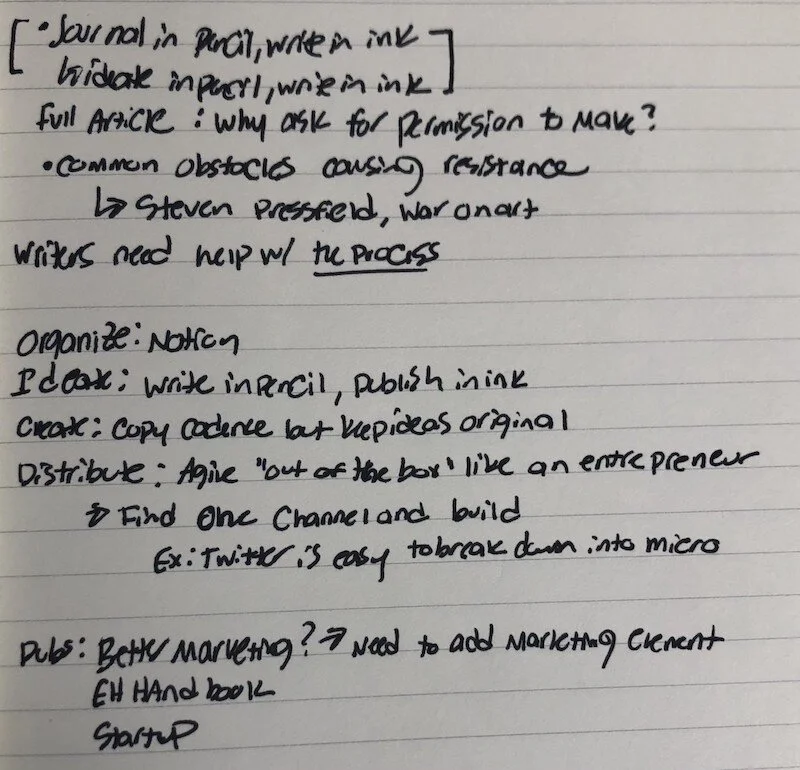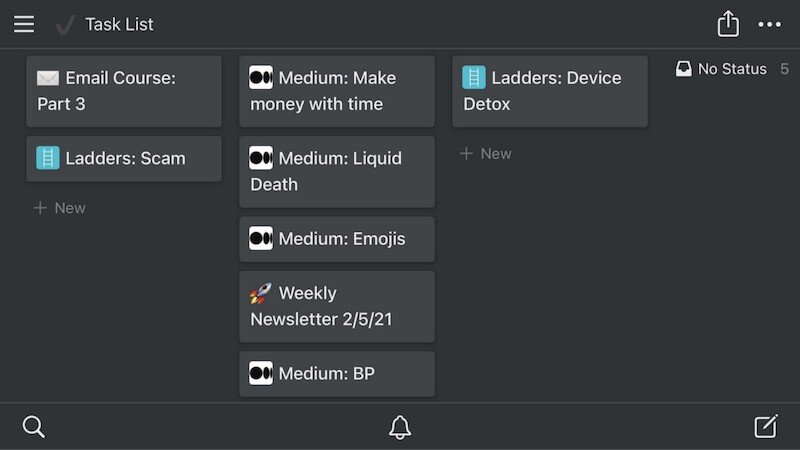Write better, faster, and more confidently with the right system
Photo by Kelly Sikkema
I came across a Chinese proverb on Twitter that I can’t get out of my head:
“Talk doesn’t cook rice.”
In so few words, it explains many underlying flaws I see with writers. We’re always thinking, planning, and talking without building. We copy ideas and call them our own. We’d rather fire off a few tweets offering advice than put our words into action. We’re afraid to do more than just write.
As I’ve learned, almost all of this creative resistance can be traced to one thing: a lack of mental frameworks holding you accountable. In other words, you’re missing a process.
Big picture thinking is easy. Talking is easy. Sitting down and fleshing out an idea from concept to distribution is much harder. That’s why most people don’t do it.
Lucky for you, I’ve spent the last three years refining my process for writing original articles down to an exact science — and it’s outlined below.
Feel free to steal, borrow, adapt, and ignore as you please.
To ideate: write in pencil, publish in ink
Every concept starts as an iPhone note or journal entry.
Here’s the first iteration of this article:
I try to avoid building out the body too much before having a high-level template to work from. I’ve found that rushing to the keyboard lends to a lot more editing and revising later on.
🔍 Related: To write is to rewrite
While handwriting an idea, I’ll start thinking of personal stories and experiences to draw from. Then, with an outline in place, I can focus solely on the details and language rather than writing split-brain trying to simultaneously figure out the overarching themes.
“When you write down your ideas you automatically focus your full attention on them. Few if any of us can write one thought and think another at the same time. Thus a pencil and paper make excellent concentration tools.”
— Michael Leboeuf
Your journal draft is in pencil, ready to be erased, scratched, and reworked. Your published draft is in ink, ready for the world to enjoy.
To organise: build a “second brain” with Notion
My biggest obstacle has always been organisation. I’ll start 15 articles at once, and slowly chip away at each of them simultaneously.
This is highly unproductive.
Notion changed the game in 2021. Everything related to my writing career is housed in one location: ideas, earnings, inspiration, links, and a running task list.
Think of Notion as an accountability system to make sure good ideas don’t disappear into your drafts while serving as a physical reminder of ongoing priorities.
Ideas are useless when they’re kept inside your head. Self-organization tools will help you take those ideas from zero to one.
To create: steal cadence, not content
Original ideas are your digital currency. Cadence is how you cash them in.
After your idea has been templated and organised, you need to determine your pacing. To this point, the article is raw. Now it needs a bit of character to drive readability and curiosity.
While writing, I study the sentence structure and stylistic devices different authors use to unfold a story. Steven Pressfield has incredible pacing. His words are quick and active, packing a ton of value into short paragraphs. He’s great for three to five minutes articles that I want the reader to zip through and retain small, but very memorable bits of information.
When writing “How To’s” or “5 Reasons Why…” remixed with a personal story, Ryan Holiday, Tim Ferriss, James Clear, and Ramit Sethi are masterful examples.
For longer pieces, I’ll watch several TED Talks and read highlighted passages from my favourite memoirs.
Again, this is all part of your system. It’s a routine. Find what works for you. Most importantly, don’t borrow anyone’s ideas. Borrow flow.
To distribute: think like an entrepreneur
Fortune favours the nimble. Entrepreneurs know this better than anyone. Study the way startup founders think. Follow different entrepreneurs on Twitter. See how they write, position, and brand themselves. Many are experts at distributing content to build relevance across many channels.
Here are a few of my current (often changing) favourites:
Jack Butcher: The art of simple
David Perrell: Actionable writing advice
Gary Vaynerchuk: Microcontent distribution
Ann Friedman: Community building
I understand the hesitation to publish in places beyond Medium or your personal blog — I’ve felt the same way. It’s intimidating. Embarrassing even. Does my high school gym teacher really need to know about my love of oat milk branding on Twitter? Unfortunately, yes.
Volume and uniqueness are essential if you want to build a level of continuity and resonance with your readers. You’ll never know whether or not certain ideas are sticking if you don’t share them in public. One platform isn’t a sufficient feedback loop.
Stop waiting. Start creating
Brainstorm in your journal first. Getting too deep into an article without direction wastes time and destroys the flow.
Use a self-organisation tool as a repository for your writing. Never again will you have to scour Google for “that one link” or the quote you can’t quite remember. It’s all there, ready to be used.
Steal cadence, not content. The intersection of your original idea with the pacing of an expert is how people separate themselves.
Distribute content like an entrepreneur. Writers today can’t rely on a single, generic message served to a mass audience. The most effective way to drive growth is by speaking specifically to different people and then refining.
Once you have a system in place, there’s never a reasonable excuse not to write and publish.
I’ll leave you with this quote from Steven Pressfield as an extra kick of motivation:
“Creative work is… a gift to the world and every being in it. Don’t cheat us of your contribution. Give us what you’ve got.”
=====



